Robert Kananaj Gallery is known for its patronage in new installation art forms that address social issues as well as philosophical or poetical thoughts. In its recent exhibition Francesco Albano’s work evokes reverence of art much like Grünewald, who defied the eminence of Renaissance classicism in favour of a realistic gruesome rendering in his painting, as his unique contribution to later-Medieval Central European art. Albano’s work is his internalized experience of our time, where social tensions influence his own conventions, reinterpretations and tradition in art. To have a better understanding of his work I asked him a few questions.
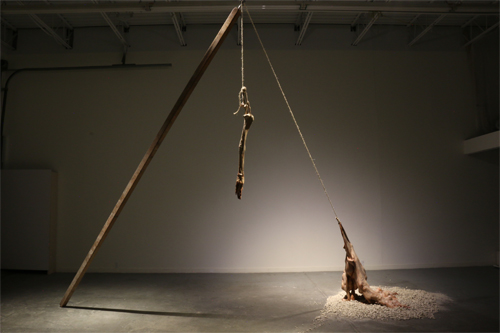 Installation view with Francesco Albano, After Grünewald. Image courtesy of Robert Kananaj Gallery
Installation view with Francesco Albano, After Grünewald. Image courtesy of Robert Kananaj Gallery
S.T: As the title of your exhibition, After Grünewald, suggests you take a lot of inspiration from Matthias Grünewald in terms of style and subject matter. What drew you to Grünewald?
F.A: The Isenheim Altarpiece by Grünewald has always been for me a recurrent and obsessive reference; for the past three years it has become a main subject of study for my artistic work.
Rendered in a radical way for the time, Grünevald’s work still resonates. “Francis Bacon: The Logic of Sensation” [Francis Bacon: Logique de la Sensation], a book by Gilles Deleuze, is where I have also drawn inspiration from. Pain and Death are the basic vocabulary of my artistic grammar. I like the description “navigation Á vue”, a French term meaning there is no reference, landmark or equipment while navigating in the unknown or looking for a pathway. I adopt this approach with my artistic practice as a sensory exploration of the Grünewald artworks: step by step, like a sailor, I discover the shores of my own artistic references to guide my journey and find or maybe lose myself in it.
Maria Magdalena of the “Isenheim Altarpiece”, the kneeling figure, faceless, boneless and red-draped – to me she evokes despair.
Today with nowhere to direct the load of society’s and the individual’s sorrow, I set a kneeling figure in a desolate landscape, alone, begging at the foot of an empty scaffold an image of human despair: a crucifixion for our time.
 Francesco Albano, After Grünewald, detail, 2016, polyester resin, wax rope, wood, gravel. Image courtesy of Robert Kananaj Gallery
Francesco Albano, After Grünewald, detail, 2016, polyester resin, wax rope, wood, gravel. Image courtesy of Robert Kananaj Gallery
S.T: Grünewald’s works mostly focus on the 2-dimensional painting medium (besides the intricately detailed altarpieces). What was the translation from painting to sculpture like?
F.A: To get started with each of my artworks I use a particular image as reference. Grünewald’s Altarpiece becomes the main source of inspiration for this exhibition’s three-dimensional installations.
The process of making a work of art is important to me, and also the capacity to know the world through touch. In my practice within trust to accidents – unpredictable things that happen during the act of making – I believe that those unforeseen outcomes are the cathartic core of the work. Catharsis through sculpture, through touch – I sculpt what I feel. The hand is the messenger.
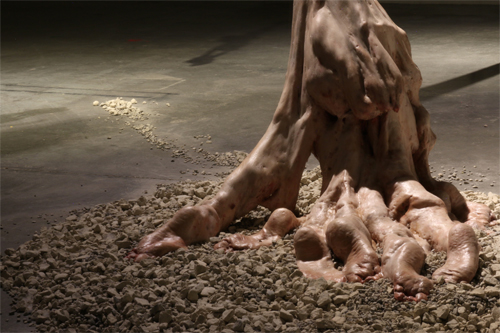 Francesco Albano, After Grünewald, detail, 2016, polyester resin, wax rope, wood, gravel. Image courtesy of Robert Kananaj Gallery
Francesco Albano, After Grünewald, detail, 2016, polyester resin, wax rope, wood, gravel. Image courtesy of Robert Kananaj Gallery
S.T: You said that the work was about a blasphemous sort of “desire,” as represented through these dysmorphic bodies. Could you elaborate a bit more on this “desire?”
F.A: For the past few years the concept of skin and bone has been the base in my work: Skin is the first, most important object of desire, of touch; landscape, organ, imprint of the soul, shroud. The skin manifests the psychological symptoms. The Greek philosopher Galen ascribed health and disease to the balance of four humors: “black bile, yellow bile, phlegm and blood.” Imbalance of the humors was outwardly manifested in the skin. In contrast, the unchanging bones become heretical dissenters, the antithesis of desire.
The impact to human body, being distorted and transformed through torments and illnesses of the soul and the psyche, relate to consuming desire, the suppression or the lack of it.
 Francesco Albano, Castaway, details, 2016, polyester resin, wax. Photo: Simon Termine
Francesco Albano, Castaway, details, 2016, polyester resin, wax. Photo: Simon Termine
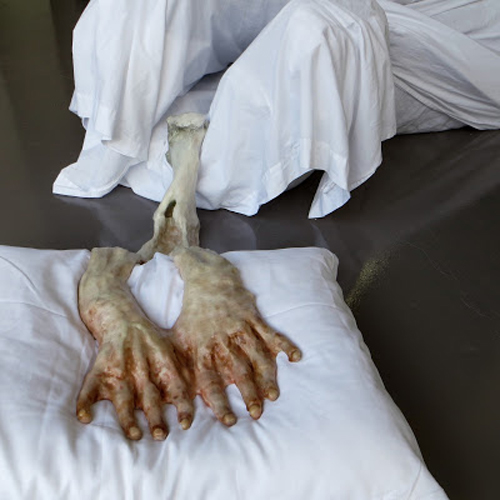 Francesco Albano, The temptation of St Anthony, detail, 2016, polyester resin, wax, mattress and bed sheets, pillow. Image courtesy of Robert Kananaj Gallery
Francesco Albano, The temptation of St Anthony, detail, 2016, polyester resin, wax, mattress and bed sheets, pillow. Image courtesy of Robert Kananaj Gallery
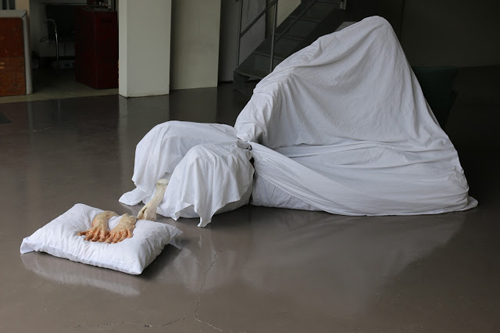 Francesco Albano, The temptation of St Anthony, 2016, polyester resin, wax, mattress and bed sheets, pillow, armchair, bungee cords. Image courtesy of Robert Kananaj Gallery
Francesco Albano, The temptation of St Anthony, 2016, polyester resin, wax, mattress and bed sheets, pillow, armchair, bungee cords. Image courtesy of Robert Kananaj Gallery
Simon Termine
*Note: The process of making the After Grünewald show became an integral part of the previous exhibition, State of Being, as it was still running, by using a makeshift studio within the gallery that is now part of the exhibition. Working on a tight schedule, Albano created and installed his entire exhibition within a month. Despite unexpected obstacles in finding his accustomed materials in an unfamiliar city, Albano, is now, looking back at his experience in Toronto, as of a happy time. He enjoyed working in his improvised studio, taking coffee breaks with Robert Kananaj, sitting on the bench outside the gallery, exploring the Bloordale neighbourhood on foot, and having opportunities to chat with visitors at the gallery.
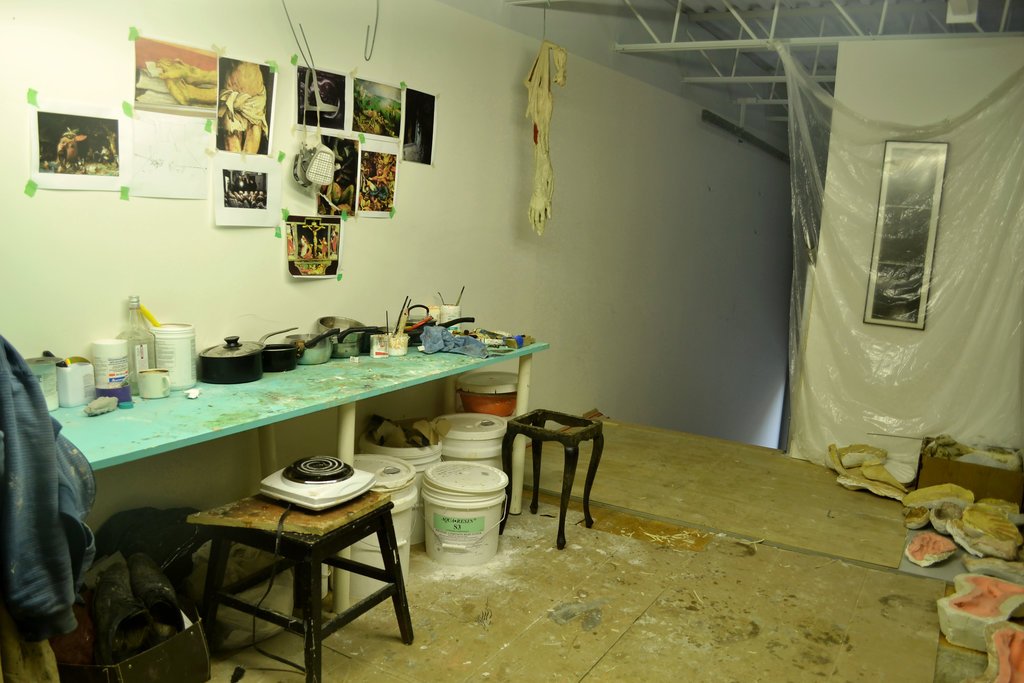 Francesco Albano’s workshop atop of Robert Kananaj’s show, State of Being, in May, 2016. Photo: Simon Termine
Francesco Albano’s workshop atop of Robert Kananaj’s show, State of Being, in May, 2016. Photo: Simon Termine
**Exhibition information: May 26 – July 16, 2016, Robert Kananaj Gallery, 172 St Helens Avenue, Toronto. Gallery hours: Tue – Sat 11 a.m. – 6 p.m.
